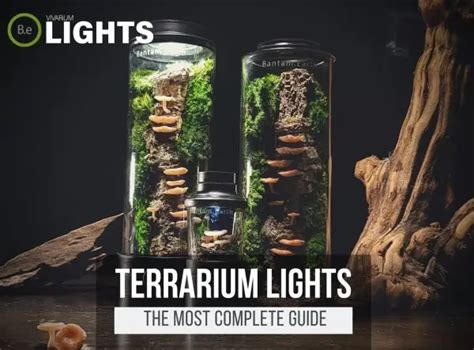Introduction
Terrariums are a fascinating and rewarding way to bring a piece of the natural world into your home. By providing a controlled environment, you can create a thriving ecosystem that mimics the conditions of a forest floor or other habitat. One of the most important factors in creating a successful terrarium is providing the right lighting.

The Importance of Terrarium Lighting
Light is essential for plants to grow and thrive. It provides the energy they need to photosynthesize, which is the process by which they convert carbon dioxide and water into glucose and oxygen. In a terrarium, the light source is not natural sunlight, so it is important to provide artificial lighting that meets the specific needs of the plants you are growing.
Choosing the Right Light
The type of light you choose for your terrarium will depend on the plants you are growing. Some plants, such as ferns and mosses, can tolerate low light levels, while others, such as orchids and carnivorous plants, require bright light.
When choosing a light, it is important to consider the following factors:
- Light intensity: The intensity of the light is measured in lumens. The higher the lumens, the brighter the light.
- Light spectrum: The light spectrum refers to the range of wavelengths of light that the bulb emits. Different plants require different light spectrums.
- Light duration: The duration of light is measured in hours per day. Most plants need 12-16 hours of light per day.
Types of Terrarium Lighting
There are a variety of different types of terrarium lighting available. The most common types include:
- Fluorescent lights: Fluorescent lights are a good option for terrariums because they are relatively inexpensive and energy-efficient. They also produce a wide range of light spectrums, making them suitable for a variety of plants.
- LED lights: LED lights are a more expensive option than fluorescent lights, but they are also more energy-efficient and last longer. They also produce a very specific light spectrum, which can be beneficial for certain plants.
- High-intensity discharge (HID) lights: HID lights are the most powerful type of terrarium lighting. They produce a very bright light that is suitable for plants that require high light levels.
How to Set Up Terrarium Lighting
Once you have chosen the right light, you need to set it up properly. The following steps will help you get started:
- Choose the right location: The location of your terrarium light is important. It should be placed so that the plants receive the right amount of light.
- Install the light: Follow the manufacturer’s instructions for installing the light.
- Adjust the light intensity: The intensity of the light can be adjusted by using a dimmer switch or by moving the light closer to or farther from the plants.
- Monitor the plants: Monitor the plants closely to make sure that they are getting the right amount of light. If the plants are not growing well, you may need to adjust the light intensity or duration.
Troubleshooting Terrarium Lighting Problems
If you are having problems with your terrarium lighting, there are a few things you can check:
- Make sure that the light is turned on: This may seem like a silly thing to check, but it is the most common cause of terrarium lighting problems.
- Check the bulb: The bulb may be burned out or loose.
- Check the power source: Make sure that the light is plugged into a working outlet.
- Check the light fixture: The light fixture may be damaged or loose.
Conclusion
Terrarium lighting is an important factor in creating a successful terrarium. By choosing the right light and setting it up properly, you can provide your plants with the light they need to thrive.





















